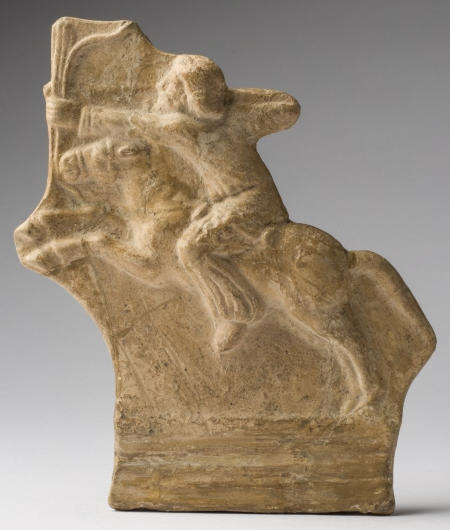
Try Amazon Audible Plus
Parthian horse-archer plaque. Syria or Iraq, 1st - 3rd century
Museum für Islamische Kunst der Staatlichen Museen zu Berlin I. 3685



Statuette (Rundplastik)
1-300AD
Dynastie - Parther
Herkunft (Allgemein): Syrien (Land)
Herkunft (Allgemein): Irak (Land)
Irdenware, gemodelt
Höhe: 17 cm
Breite: 3 cm
Tiefe: 14,5 cm
Ident.Nr. I. 3685
Sammlung: Museum für Islamische Kunst
© Foto: Museum für Islamische Kunst der Staatlichen Museen zu Berlin - Preußischer Kulturbesitz
Fotograf/in: Johannes Kramer
Description: Reitender Bogenschütze. Der Reiter ist durch sein Gewand, das Reiten ohne Steigbügel sowie Pfeil und Bogen als parthisch gekennzeichnet, auch wenn er nicht in der für die Parther charakteristischen Bogenschusshaltung dargestellt ist. Zahlreiche antike Autoren berichten von der erfolgreichen und gefürchteten Kampftaktik der Parther, eine Flucht mit sprengenden Pferden vorzutäuschen und dabei, rückwärts gewandt, Pfeile abzuschießen.
Statuette
1st - 3rd century
Dynasty - Parthian
Origin: Syria or Iraq
Earthenware, modeled
Height: 17 cm
Width: 3 cm
Depth: 14.5 cm
ID No. I. 3685
Collection: Museum of Islamic Art
© Photo: Museum of Islamic Art of the National Museums in Berlin - Prussian Cultural Possessions
Photographer: Johannes Kramer
Description: Horse-archer. The rider is characterized by his robe, riding without stirrups and bow and arrow as Parthian, even if it is not shown in the characteristic Parthian archery pose. Numerous ancient authors report on the successful and dreaded battle tactics of the Parthians, feigning flight with galloping horses and shooting arrows backwards.